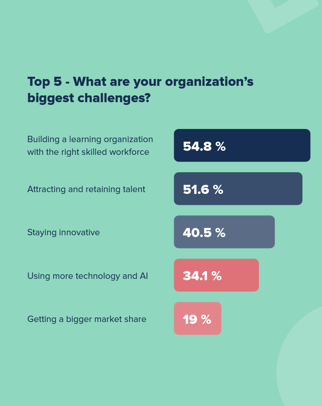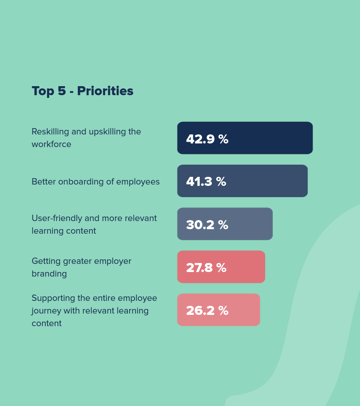A clean slate? Or new inspiring ideas for your learning strategies moving into 2022? Maybe you have not even given it a lot of thought - yet. Anyway, as 2022 approaches it might be interesting to take a look at what other HR professionals in the Nordics are planning to do, and what they have done so far in 2021.
Our annual survey of the learning trends in the Nordics has just ended, and here, we provide you with a little sneak peek of the insights that we have gained so far.
Top 5: What Are Your Biggest Challenges?
As something new we asked specifically people working in HR, but not on C-Level, about their challenges and top priorities and how they connected learning to these. And their top 5 of their biggest challenges right now are:
- Not enough time to strategize and thinking long-term (34.4 %)
- Change management due to business disruption (23.4 %)
- Most time spent on administration (20.3 %)
- Communication Issues (17.2 %)
- An Overwhelming Workload (15.6 %)
This is a clear shift from the top 5 in the Nordic Learning Trends 2020, where building a learning organization with the right skilled workforce was the number one challenge:
 Source: Nordic Learning Trends 2020, Learningbank
Source: Nordic Learning Trends 2020, Learningbank
However, the challenges from 2020 might reflect on the top priorities from 2021/22. More about that later. Let's start by digging into the number one challenge for HR professionals in the Nordics.
Strategizing and Thinking Long-Term
The HR professional today is wearing many different hats. We talked about this in the report from 2020, and it is still valid today. Responsibilities like recruitment, learning and development (L&D), employer branding, internal communications, preboarding, onboarding, reboarding, and offboarding, are just some of the tasks that HR professionals deals with in their work lives. No wonder that strategizing and thinking long-term can be difficult and is the major challenge for the Nordic Learning Trends 2021/22.
Furthermore, COVID-19 showed us that a solid plan can be tossed right out the window when an unforeseen pandemic hits the globe and changes everything - also at our workplaces.
But strategizing is key for business survival in the long run, and it is important for HR professionals to set aside time for this in their daily workflow. A solution is thinking about how other tasks are managed today. Can the digital part of the pre- and onboarding phase become automated? And the same goes for multiple other L&D-initiatives? Some learning platforms are capable of handling these tasks, and, in that way, you release time to strategize and thinking long-term, when digital automation tools handle them for you.
Top 5: What Are Your Top Priorities?
As we mentioned, there is an overlap, when we look at the top challenges from the Nordic Learning Trends 2020 and compare it to the top priorities in 2021/22. Let's look at the five top priorities for HR professionals in the Nordics:
- Reskilling and upskilling the workforce (32.2 %)
- Creating more competent and modern managers/executives (31 %)
- Increasing employee satisfaction (31 %)
- Supporting the entire employee journey (Pre-, On-, Re-, and Offboarding) with relevant learning content (29.9 %)
- Hiring people with the right skills for the modern workforce (24.1 %)
It is both similar to the priorities from the report from last year, but also according to the challenge from last year. Here are the top priorities from Nordic Learning Trends 2020:

Source: Nordic Learning Trends 2020, Learningbank
Creating more modern and competent managers and increasing employee satisfaction are new on this year's survey top 5. And it makes sense when we look at the year that has passed. Employees need to get a boost in their psychological wellbeing post-COVID-19 and we need managers who are able to kickstart that boost. Let's move on to the top priority of this year's Nordic Learning Trends 2021/22.
Reskilling and Upskilling the Workforce
They say it in the Nordics, but they definitely say it too on a global scale. Reskilling and upskilling is the absolute top priority for HR professionals worldwide. Two-thirds (66%) of L&D pros globally now agree that they are focused on rebuilding and reshaping their organizations - according to LinkedIn's Workplace Learning Report 2021. Also, 59 %, have made upskilling and reskilling their top priority. A 15 % increase from June 2020.
And if we stay in the reskilling area, an interesting fact occurred in the LinkedIn report. If you invest in reskilling and internal mobility, employees are likely to stay at your company for almost 2x longer. On average an employee stays with your company for 2.9 years if you have low internal mobility and 5.4 years if you have high internal mobility.
Why is upskilling and reskilling so important? Well. You might have heard it. But the workforce is changing fast. In the next couple of years, 85 million jobs will be displaced and 97 million new jobs will get created. Both the displacement and creation are especially due to automation and robot evolution. That's why we have to think about up - and reskilling. We need to adapt the workforce to the changes and build new career paths that tap into the future of work - both for the individual employee, but also for our companies and organizations to win new markets and stay on top of the game.
How Do You Think 'Learning' when Looking at Your Biggest Challenges and Priorities?
The final sneak peek from the Nordic Learning Trends 2021/22 is all about how HR professionals think 'learning' when it comes to priorities and challenges.
- We made a learning strategy to upskill and reskill employees due to our specific challenges and priorities (28.7 %)
- We are still reflecting and planning how to cope with our challenges and priorities and create learning which relates to these (27.6 %)
- We feel somewhat ready to develop future skills due to our challenges and priorities (25.3 %)
This is a new question in the Nordic Learning Trends Survey, and the good news is that most people have made a clear learning strategy to cope with the changes or reflect and plan to cope with them. So, even though we learned that HR professionals in the Nordics are busy, this past year has still started some thoughts about how to tackle challenges going forward. And that employees in the Nordics can look forward to great upskilling and reskilling challenges in the future.
Soon, you will be able to read the rest of the Nordic Learning Trends Report 2021/22, and here are some of the other topics that you will learn about:
- HR Tech Trends
- Digital vs. training events on the floor
- Hours spent on employee training
- User-Generated Content (UGC)
- Most popular training formats
- Most popular skills and learning processes
- Learning outcomes


